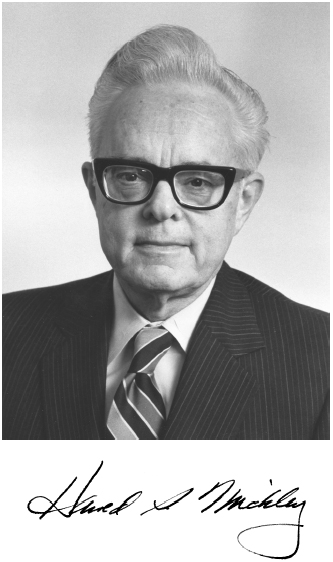
1918–2011
Elected in 1978
“For original research on transpired turbulent boundary layers and for creativity and leadership in the industrial development of oxychlorination processes.”
BY KENNETH A. SMITH
HAROLD SOMERS MICKLEY had a major impact on both chemical engineering education and the industrial practice of chemical engineering. He died in Sarasota, Florida, on December 3, 2011.
Harold was born on October 14, 1918, in Seneca Falls, New York, the only child of Marguerite and Harold F. Mickley. His father, a US army physician, died before his son’s birth, a victim of the 1918 influenza pandemic. Harold’s mother subsequently moved to Long Beach, California, where she remarried. Harold grew up there and enrolled at Caltech, where he studied chemistry and was exposed to a mode of thought that emphasized physics, chemistry, and mathematics. His advisor, Linus Pauling, was a significant factor in developing in Harold a pattern of thinking that was rigorous and demanding. During this period, Harold supported himself in part by contributing science fiction pieces to Amazing Stories magazine.
Upon graduation in 1941, he wed Margaret Phillips, whom he had met during his Long Beach school days. Sons Steven and Richard followed in 1945 and 1948. Sadly, Margaret predeceased Harold. He later married Edith James and is survived by her, Steven (Diane), Richard (Cynthia), and seven grandchildren.
Despite his love of science, Harold desired a career that could more directly enhance the lives of others, so he chose to enroll in chemical engineering at MIT for his graduate education. The country was by then fully involved in World War II and Harold undertook classified research on torpedo propulsion. This led to the award of his ScD in 1946 and an appointment to the MIT faculty.
Harold rapidly became known as an expert in fluid mechanics, heat and mass transfer, heterogeneous catalysis, and industrial chemistry. He was among the first to realize that research was badly needed to improve understanding of the transpired turbulent boundary, which is central both to the cooling of turbine blades and reentry vehicles and to problems in which the mass transfer rate is high. He was the lead author (with T.K. Sherwood and C.E. Reed) of Applied Mathematics in Chemical Engineering (1957), for decades a standard in graduate chemical engineering curricula. Recent Advances in Heat and Mass Transfer (with J.P. Hartnett, E.R.G. Eckert, and R.L. Pigford) followed soon thereafter (1961). He also initiated (with T.B. Drew) the writing of an advanced undergraduate text, Understanding and Predicting the Interactions of Matter, Energy, and Forces. Twenty chapters were drafted and, for a decade, the blue ditto copies were an important element in the education of MIT undergraduates in chemical engineering.
These activities placed Harold in the forefront of those who, in the early 1960s, were changing engineering education to increase emphasis on mathematics and science. In recognition of this, he was named in 1961 the prestigious Ford Professor of Engineering at MIT, and in 1962 he was promoted to chairman of the MIT faculty. In that capacity, he attracted the attention of Alfred P. Sloan, who asked him to be the founding director of MIT’s Center for Advanced Engineering Study. This novel educational experiment was devoted to the continuing advancement of engineers employed in industry. Under Harold’s leadership, the Center became a pioneer in what is now known as “distance education.”
He was also highly valued as a consultant to many international chemical and petroleum firms, and in 1967 he
accepted a position as technical director at Stauffer Chemical Company, where he rose to the position of executive vice president in 1971, responsible for research and engineering leadership and for interactions with economic and societal considerations. (Much of this was proprietary and is therefore not available for review.) But his thirst to participate in technological activities was irrepressible, and many of his 50 patents are based on work undertaken at Stauffer Chemical Company; his contributions to Stauffer’s oxychlorination process are especially apparent.
Harold’s greatest impact may have been as a mentor, the common denominator of his careers in academia and in industry. He believed deeply in honesty, fairness, commitment to the truth, hard work, and generosity. He demanded these of himself and provided the example for us. It was not always easy to comport with the associated expectations, but we are far better for trying. His example and his generosity demonstrated his humanity, and we miss him.




